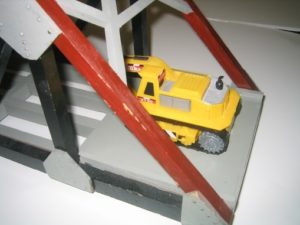Model Description
This 3D model of a bridge is a model that is very close to a real representation of a bridge. It has a number of realistic features that cannot be shown with K’NEX or other simple structures. This demonstration should take 15-20 minutes.

Engineering Principle
Bridges are more than just trusses put together. There are other important factors to a bridge that keep it stable and functional. This bridge uses gusset plates to form joints, a roadway, lateral supports to keep the trusses vertical, supports on both ends, and even curbs. It is also strong enough to hold real loads on its roadway.
What You Need
| Item | Quantity | Description/Clarification |
|---|---|---|
| Wood | Lots! | Measurements for the bridge have been included in pictures. It is about a yard long at the bottom, two feet long at the top, and seven inches wide. The members are all about ¾” thick and ½” wide. The plates are each ⅛” thick. The two sections of roadway are 6″ x 6″ x ⅛” with ⅛” curbs on either side. 2-3 hours for construction. |
| Paint | Any | We used three colors: red, black and grey. It adds a nice touch to the presentation. |
| Nails | Lots! | Nails are used to hold the bridge together. |
| Car/truck | 1 | A battery-operated car or truck can drive across this bridge safely. |
How It’s Done
Before Class: Construct the bridge out of the wood and test it with an acceptable load to make sure it doesn’t overload and break during class. There is no real requirement to support a load, but it allows additional realism.
In Class: Bring out the bridge and ask the class what distinguishing features represent a real bridge. Talk about each characteristic with the class.
Gusset Plates: This bridge doesn’t just have pins to form the joints, it has plates connecting the members that act like pins. The connections for this bridge represent gusset plates connected to members by bolts or rivets. A discussion as to why it still can represent a pin connection should ensue. The forces in the members coming into a joint are intersecting at a single point – a concurrent force system. Therefore, there is no tendency to cause rotation – so can be represented as a pin connection. Demonstrate by putting a load on the roadway. The load is transferred from the roadway to the beams running parallel to the bridge span that transfer the load to a girder running perpendicular to the span that transfers the load to the truss joints where the members are connected by a gusset plate. Therefore, all the members are truss members and the load is only applied at the joints of the truss.

Roadway: Point out the roadway. The load is transferred from the roadway to the beams running parallel to the bridge span that transfer the load to a girder running perpendicular to the span that transfers the load to the truss joints where the members are connected by a gusset plate. Place a load on the road to demonstrate its strength and transfer of load. Could add fun and drama by placing a motorized vehicle on the roadway. Begin explaining how the load is transferred and part of the way through the explanation, make the car or truck drive across the bridge. Also, point out the curbs that are on either side of the roadway and how they add additional load.

Lateral supports across the top of the bridge: In real bridges, trusses cannot stay vertical when the loads are applied to them – lateral torsional buckling. Same thing that happens to most long members with a load applied perpendicular to length. This bridge has supports (some forming triangular shapes as well) added to the top to keep the two trusses vertical and prevent lateral torsional buckling.

Partial abutments on either end: The bridge is built with a partial abutment on each end for placement on the two edges of the space being crossed. Abutments are necessary for real bridges and transfer the load from the bridge into the soil.

Additional Application: Using a sturdy wooden structure as described above, real issues such as overhead clearance, lateral supports, abutments, etc. can be discussed. Real looking connections that do not represent idealized pin connections are brought to life.

